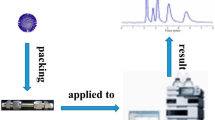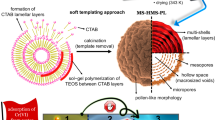Abstract
TiO2 hollow microspheres with sea urchin-like hierarchical architectures were synthesized by a simple hydrothermal method. The as-synthesized hollow microspheres with hierarchical architectures consisting of many rhombic building units exhibit high specific surface area. Electrorheological (ER) properties of hierarchical hollow TiO2-based suspension were investigated under steady and oscillatory shear. The hollow TiO2-based suspensions show much higher yield stress and elasticity than pure TiO2 suspension at the same electric field strength. This phenomenon was elucidated well in view of their dielectric spectra analysis. The sea urchin-like architectures result in stronger interfacial polarization of hollow TiO2 suspension upon an electric field, showing higher ER activity. Also, hollow interiors of TiO2 particles increase the long-term stability of suspensions and further merit the ER effect.








Similar content being viewed by others
References
Wen W, Huang X, Yang S, Lu K, Shen P (2003) Nat Mater 2:727
Block H, Kelly JP (1988) J Phys D Appl Phys 21:1661
Hao T (2001) Adv Mater 13:1847
Whitesides GM, Grzybowski B (2002) Science 295:2418
Shen R, Wang X, Lu Y, Wang D, Sun G, Cao Z, Lu K (2009) Adv Mater 21:4631
Yin J, Zhao X, Xia X, Xiang L, Qiao Y (2008) Polymer 49:4413
Hong JY, Kwon E, Jang J (2009) Soft Matter 5:951
Yin J, Xia X, Xiang L, Zhao X (2010) J Mater Chem 20:7096
Zhang WL, Park BJ, Choi HJ (2010) Chem Commun 46:5596
Hong JH, Jang J (2010) Soft Matter 6:4669
Choi HJ, Jhon MS (2009) Soft Matter 5:1562
Cao JG, Shen M, Zhou LW (2006) J Solid State Chem 179:1565
Liu F, Xu G, Wu J, Cheng Y, Guo J, Cui P (2010) Colloid Polym Sci 288:1739
Yin J, Zhao X (2004) Chem Mater 16:321
Yin J, Zhao X (2006) Nanotechnology 17:192
Yin J, Zhao X, Xiang L, Xia X, Zhang Z (2009) Soft Matter 5:4687
Li X, Xiong Y, Li Z, Xie Y (2006) Inorg Chem 45:3493
Cho MS, Cho YH, Choi HJ, Jhon MS (2003) Langmuir 19:5875
Cheng Q, Pavlinek V, He Y, Li C, Saha P (2009) Colloid Polym Sci 287:435
Klingenberg DJ, Van Swol F, Zukoski CF (1991) J Chem Phys 94:6170
Tsuda K, Takeda Y, Ogura H, Otsubo Y (2007) Colloid Surf A: Physicochem Eng Asp 299:262
Wang B, Zhao X (2005) Adv Mater 15:1815
Hiamtup P, Sirivat A, Jamieson AM (2006) J Colloid Interface Sci 295:270
Cho MS, Choi HJ, Ahn WS (2004) Langmuir 20:202
Block H, Rattay P (1995) In: Havelka KO, Filisko FE (eds) Progress in electrorheology. Plenum, New York, p 19
Ikazaki F, Kawai A, Uchida K, Kawakami T, Edamura K, Sakura K, Anzai H, Asako Y (1998) J Phys D Appl Phys 31:336
Hao T, Kawai A, Ikazaki F (1998) Langmuir 14:1256
Hao T, Kawai A, Ikazaki F (1999) Langmuir 15:918
Kim SG, Lim JY, Sung JH, Choi HJ, Seo Y (2007) Polymer 48:6622
Acknowledgment
This work was supported by the National Natural Science Foundation of China (20925621), the Special Projects for Nanotechnology of Shanghai (1052 nm02300, 0952 nm02000, and 0952 nm02100), the Shanghai Pujiang Program (09PJ1403200), the Program of Shanghai Subject Chief Scientist (08XD1401500), the Special Projects for Key Laboratories in Shanghai (10DZ2211100), and the Fundamental Research Funds for the Central Universities (WD1013014). The authors also wish to thank the financial support of the Ministry of Education, Youth, and Sports of the Czech Republic (MSM 7088352101) and Grant Agency of the Czech Republic (202/09/1626).
Author information
Authors and Affiliations
Corresponding author
Rights and permissions
About this article
Cite this article
Cheng, Q., Pavlinek, V., He, Y. et al. Synthesis and electrorheological characteristics of sea urchin-like TiO2 hollow spheres. Colloid Polym Sci 289, 799–805 (2011). https://doi.org/10.1007/s00396-011-2398-8
Received:
Revised:
Accepted:
Published:
Issue Date:
DOI: https://doi.org/10.1007/s00396-011-2398-8




